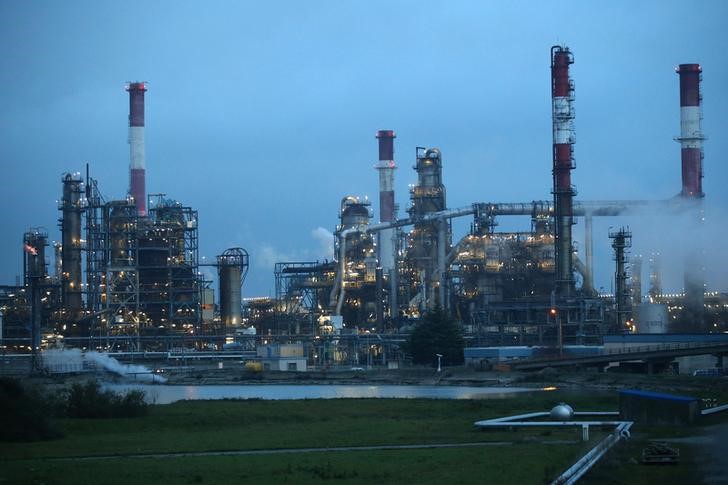 © Reuters. A view shows the French oil giant Total refinery in Donges
© Reuters. A view shows the French oil giant Total refinery in DongesBy Henning Gloystein
SINGAPORE (Reuters) – Oil prices were firm on Wednesday, receiving ongoing support from healthy economic growth as well as from supply restrictions led by a group of producers around the Organization of the Petroleum Exporting Countries (OPEC) and Russia.
Spot futures, the international benchmark for oil prices, were at $70 a barrel at 0102 GMT, up 4 cents from their last close and not far off the Jan. 15 three-year high of $70.37.
U.S. West Texas Intermediate (WTI) crude futures were at $64.59 a barrel, up 12 cents from their last settlement and close to a December-2014 high of $64.89 from Jan. 16.
In the latest sign of healthy global economic growth, Japanese manufacturing activity expanded at the fastest pace in almost four years in January, a survey showed on Wednesday.
Economic growth is translating into healthy oil demand growth, which comes at a time that OPEC and Russia lead production cuts aimed at tightening the market and propping up prices. The deal to withhold output started in January last year and is currently set to last through 2018.
Stephen Innes, head of trading for Asia/Pacific at futures brokerage Oanda in Singapore said a “beaming economic forecast along with stout compliance from OPEC (to withhold production) is providing convincing support.”
OPTION TO SELL
Despite the overall supportive market conditions, which have seen crude futures rally by almost 15 percent since early December, there are signs that traders are preparing for a downward correction.
One way of doing that is to take out so-called put options on crude futures contracts which give a trader the right, but not the obligation, to sell at a certain price.
“The options market shows increased demand for downside protection. This makes sense considering how one-sided (to the upside) the speculative bets have become,” said Ole Hansen, head of commodity strategy at Saxo Bank.
Trading data shows that open interest, describing the amount of positions that have yet to be settled, for Brent put options to sell at $70, $69 and $68 per barrel has surged since the middle of last week on the Intercontinental Exchange (ICE).
Overall, there is now far more demand for options to sell Brent than there is for call options, which are the right to buy Brent at a certain price.
Hansen said using put options was a way “to express the opposite view of the current (upward) trend” and that “corrections of between 10-15 percent have previously been seen once the music stopped and traders began booking profit”.
Fusion Media or anyone involved with Fusion Media will not accept any liability for loss or damage as a result of reliance on the information including data, quotes, charts and buy/sell signals contained within this website. Please be fully informed regarding the risks and costs associated with trading the financial markets, it is one of the riskiest investment forms possible.
Source: Investing.com





























